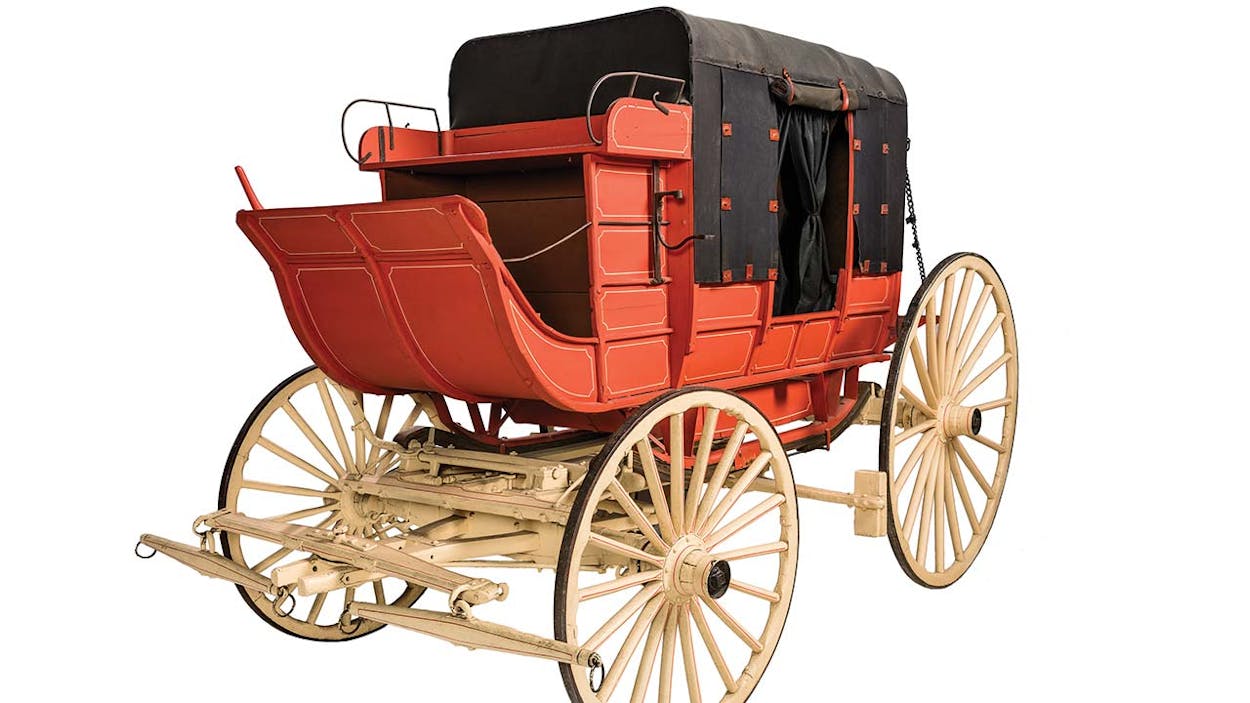The phrase “stagecoach days” brings up visions of the swaying carriages pulled by teams of six horses that are familiar to us from watching westerns and Wells Fargo commercials. These majestic vehicles were Concord coaches, made by the Abbot-Downing Company, in Concord, New Hampshire. The plush-lined compartments were about four feet wide and four and a half feet high and could carry nine passengers in relative comfort on three benches; another nine could ride on the roof. Their swaying motion was the result of thoroughbraces, multilayered three-inch-thick leather straps that were fastened to iron stanchions on the running gear to support the coach’s body. Mark Twain described the Concord as “an imposing cradle on wheels.” Over a period of fifty years, Abbot-Downing built about three thousand of these coaches and sold them to stage lines in the United States, South America, Australia, and Africa.
A few Texas stage lines used Concord coaches. Lieutenant Colonel Arthur Freemantle, a British Army officer who visited Texas in 1863, rode in one from San Antonio to Alleyton, outside Columbus, and recorded in his diary that he was reluctant to put his head out the window for fear of “a shower of tobacco juice from the mouths of the Southern chivalry on the roof.” However, in addition to being expensive—costing $1,200 in the 1840’s—the coaches were also extremely heavy. Weighing about 2,500 pounds, they were best suited to well-graded and relatively flat roads, the kind, more often than not, that weren’t found in Texas.
A far more common vehicle on Western stage lines was the smaller, lighter, and less expensive celerity wagon, from the Latin celer, for “swift.” Also known as a mud wagon, it weighed half as much as a coach and was far more effective on sandy or muddy roads and steep terrain. It was designed for speed and stability rather than comfort. The body of a mud wagon was more wagon than coach. It had a light canvas top stretched over wooden struts and canvas side curtains to protect passengers from the weather. There were no doors; passengers climbed over the low sides to take their seat on the three boards that were placed across the body. On some models, the seat backs folded down to turn the wagon into a large bed. Waterman Ormsby, a correspondent for the New York Herald, who traveled as the only passenger in a mud wagon on part of the inaugural trip across the Butterfield Overland Mail trail, in 1858, wrote that when the seat backs were down, the bed was “capable of accommodating four to ten passengers, according to their size and how they lie. I found it a very agreeable bed for one.”
Mud wagons were believed to have been designed by John Butterfield, one of the founders of the Butterfield Overland Mail, and they were built not only by Abbot-Downing Company but also by two other companies, based in New York: James Goold’s Albany Coach Works, in Albany, and the Gilbert Company, in Troy. A mud wagon’s wheels were smaller, wider, and placed farther apart than a coach’s, providing better purchase on soft ground and a lower center of gravity. The flat-bottomed body was attached to an iron frame, which was clamped to leather thoroughbraces, which in turn were shackled to the running gear in such a way that the vehicle did not sway from side to side, like a coach, but instead floated forward and backward with jolts from the road surface. The ride was so uncomfortable that a newspaper advertisement for a stage line from San Antonio to Austin in 1875 included the disclaimer “No Mud Wagons Used” in large black type.
The Witte Museum, in San Antonio, is home to a wagon that was part of the stage line that connected San Antonio to Corpus Christi and Brownsville in the late 1860’s. That route ran across the King Ranch and was used by Captain Richard King. The coaches frequently fell behind schedule, and in a fit of impatience, King bought the line. He improved the service by employing better horses, but he was unable to make the operation profitable. When Tom Lea was working on a history of the King Ranch, Richard King III told him a story that might explain why. Captain King put his son, Richard Junior, in charge of running the line, and Richard Junior had a tendency to provide all his friends with free passes. Soon everybody in South Texas was riding the stage for free, so Captain King laid down the law: no more passes. The next time the stage arrived at its stop, loaded down with free riders, all of whom were friends of the Kings, Richard Junior announced the new policy and was met with a barrage of bitter complaints. Captain King was present and, after listening for a few minutes, grinned and said, “Guess we’ll have to waive the new order this time.”
The stage line folded in 1875, but King kept this particular wagon, which was pulled by two horses, and used it for his personal transportation around the ranch. After Captain King’s death, in 1885, Richard Junior inherited the mud wagon and kept it in service on his La Puerta de Agua Dulce Ranch. In 1926 King III presented it to the Witte Museum, where it is now on display in the Robert J. and Helen C. Kleberg South Texas Heritage Center, a reminder of the days when it took forty hours to travel from San Antonio to Corpus Christi—if the stage was on time.
Witte Museum, 3801 Broadway, San Antonio (210-357-1900). Open Mon & Wed–Sat 10–5, Tue 10–8 & Sun noon–5.







